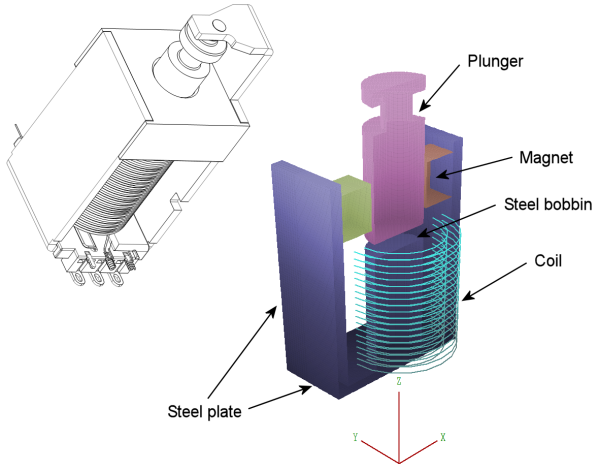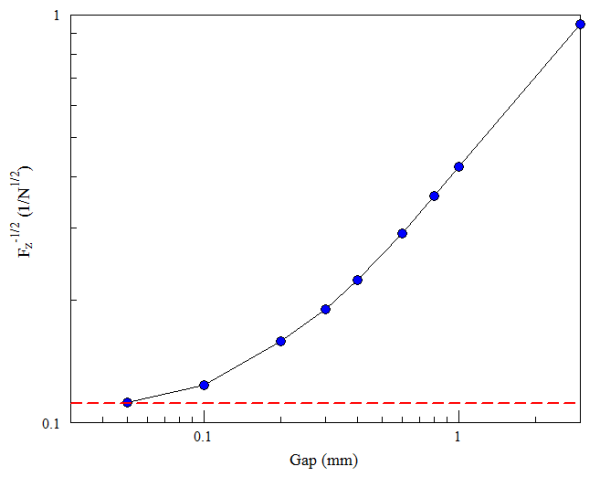With computers of increasing speed and power, it's tempting to use numerical methods for everything. Because I'm old school (or maybe just old), I always enjoy a calculation where a few minutes of thought can circumvent hours wasted on the computer.
I was recently asked by a manufacturer to prepare a demonstration showing how to use Magnum to characterize forces in a latching solenoid. Figure 1 shows a drawing of the solenoid assembly and the mesh I created with MetaMesh. The neodymium-iron permanent magnets are magnetized in the direction pointing toward the plunger. They provide a resting holding force to keep the plunger in contact with the steel bobbin. Depending on the current polarity, the coil may work in opposition to the permanent magnet to unlatch the solenoid or it may assist the permanent magnet to pull in the plunger.

Figure 1. Latching solenoid geometry.
Force calculations were easy when the plunger was separated from the bobbin. In this case, the plunger was surrounded by air (μr = 1.0) elements. I used the Surface integral command in MagView. With the configuration file magview_standard.cfg, the integral gave force components determined from the Maxwell stress tensor. The manufacturer was particularly interested in the holding force in the latched state (i.e., plunger touching the bobbin with no coil current). In this case, a Maxwell integral around the plunger could not be applied because the plunger and bobbin were effectively the same piece of material. Thinking numerically, my original impulse was to perform a series of calculations with an air gap of decreasing width dg. The intent was to fit the force variation with an interpolation function that could be extrapolated to zero gap.
The blue dots in the next figure show some results of the calculation. A simple plot of Fz versus dg was not be particularly informative because the force varied by two orders of magnitude over the separation range. The strong variation reflected the familiar experience of two magnets snapping together when they are close. I observed that the force scaled as ~1/dg2 for gaps greater than 0.5 mm. Therefore, I constructed the figure as a log-log plot of Fz-1/2 versus dg. The plot shows that the force was tended toward a constant value at zero spacing. This approach was ineffective, both in terms of the effort involved and the numerical accuracy. It was necessary to use very small gap widths (dg = 0.05 mm) to observe the inflection toward a constant value. There were large error brackets in a polynomial fit to the calculated points.

Figure 2. Scaled force variation as a function of gap width.
Fortunately, I discovered a simpler way to determine the exact holding force from a knowledge of the flux distribution when dg = 0.0 mm. Suppose we displaced the plunger an infinitesimal distance dx from the bobbin. The field in the air gap would remain confined to the cross section area A of the steel parts with a value approximately equal to the zero gap field, B0. The change in field energy in the magnet circuit is
dU ≅ (B02/2 μ0) A dx.
Using the principle of virtual work, the holding force was
Fz = - dU/dx = - (B02/2 μ0) A.
With a plunger diameter of 10.0 mm, the area was A = 7.854 ? 10[5] m2. The Magnum calculation yielded an average magnetic flux density B0 = 1.61 tesla, implying a total force of Fz = -80.935 N (plotted as a dashed red line in the second figure). The mass equivalent was 8.25 kG. This value was a maximum because the force depended sensitively on the accuracy of the surface contact between the plunger and bobbin. Even the smallest gap would give a significant reduction. For comparison, the manufacturer measured values in the range 6-7 kG.
This calculation illustrates how it is often better to combine numerical and analytic methods. In this case, a numerical calculation was necessary to find the flux density distribution B0 at zero gap. On the other hand, analytic insights were much more effective than a literal numerical approach to determine the holding-force.
LINKS